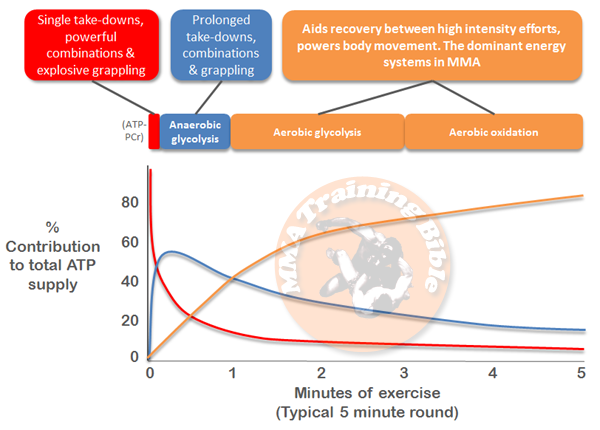This five-part article series has explored the metabolic demands of mixed martial arts. When you understand this, not only will you appreciate why you fatigue or gas-out in the cage, but you will know how to bring about specific physiological and biochemical adaptations that will optimize your performance on fight day.
In Part 1 you learned about the basics of energy transfer. Part 2 and Part 3 focused in on the anaerobic energy systems. These systems support powerful movements, like take-downs and high intensity combinations but they do not support your ability to perform powerful movements over and over again. The ability to perform repeated efforts at a high intensity over a whole round and over a whole fight is supported by the aerobic energy systems. Part 4 focused on aerobic glycolysis, which supports activity in the 90 s to 3-minute range. It also aids recovery between high intensity efforts and powers high intensity movement in the cage.
This article will focus on aerobic oxidation, which supports activity that lasts longer than 3 minutes, but it is also aids recovery between high intensity efforts and allows you to maintain a high pace throughout your entire fight. The main objectives of this article are to, 1) teach you how this system works; 2) show you how to target it with exercise; 3) list the physiological and biochemical adaptations that may occur when you train it. Let’s address the first point.
How the systems work
Aerobic oxidation supports activities lasting longer than 3 minutes. The contribution this energy system makes towards your energy over a typical five minute round is shown below in Fig 9.
 Fig 9. The ATP-PCr system supports maximal activity in the 0 s to 30 s rang. Anaerobic glycolysis supports prolonged high intensity efforts lasting 30 s to 90 s. Aerobic glycolysis supports activity in the 90 s to 3 minute range. Aerobic oxidation supports activity beyond 3 minutes.
Fig 9. The ATP-PCr system supports maximal activity in the 0 s to 30 s rang. Anaerobic glycolysis supports prolonged high intensity efforts lasting 30 s to 90 s. Aerobic glycolysis supports activity in the 90 s to 3 minute range. Aerobic oxidation supports activity beyond 3 minutes.Aerobic oxidation can generate a lot of energy, but at a much slower rate than the anaerobic energy systems. This energy is generated in two big enzymatic reactions that require oxygen; the first is reaction is called the Krebs cycle and the second is the called the electron transport chain. Don’t worry; the details of these reactions are beyond the scope of this article.
Targeting aerobic oxidation
In the previous parts, the work intervals that we used to target the energy systems were fairly short. For example, you can target the ATP-PCr system using intervals less than 30 s, anaerobic glycolysis could be influenced using intervals in the 30 s to 90 s range, and aerobic glycolysis could be targeted using work intervals of 90 s to 3 minutes. Aerobic oxidation can be targeted using work intervals that are 3 minutes or longer.
There are two classifications of training that can be used to target the aerobic oxidative energy system. One is called low intensity endurance training, which features low power output activities that must be undertaken for a long period of time, like marathon running. The other way to target aerobic oxidation is by using high intensity endurance training. This consists of working at a much higher intensity, but for a shorter period of time. High intensity endurance training is also called interval training, and it’s what we’ve been using in the workout examples up to now.
Numerous research studies have shown that low intensity, long duration endurance training will impede strength and power gains compared with high intensity interval training (1, 5). This is probably because low intensity endurance training causes your intermediate muscle fibres to become more oxidative (i.e. slow twitch), which can impeded muscular growth and your capacity to perform the strong and powerful movements that are required in MMA.
Several studies have shown that high intensity interval training in the region of four to five minutes consistently improves aerobic fitness (VO2max), probably by increasing stroke volume and cardiac output (2-4, 7). This suggests that an interval length of five minutes is probably the upper limit of what fighters in MMA should be using. Fighters wanting to burn more body fat may engage in lower intensity endurance training, as this may be an effective method to achieve their goals, but high intensity endurance training combined with dietary control may also prove effect, and has the added benefit of preserving muscular strength and power.
Targeting aerobic energy systems
When your goal is to improve aerobic metabolism (which is the use of oxygen by your muscles) you also target the systems that deliver oxygen to the muscle. To accomplish these goals, you need to make sure that your muscles are not impaired by metabolite accumulation or depletion of PCr, as these factors will impair your performance. To achieve this, you need to work at a lower intensity compared to when you are targeting the other energy systems, and you should be using work-to-rest ratios of 1:0.5 to 1:1.5 (6, 8). Typical workouts that target aerobic metabolism would look like this: 4 x 5 min on, 2.5 min off). I don’t mean to be redundant, but many possible workouts can target aerobic energy systems, so if you’re looking for support designing a fully periodized training plan, consider enrolling in our online training courses.
Training adaptations
Endurance trained individuals metabolize more triglycerides or fatty acids and less glycogen or glucose at the same absolute workload or pace, resulting in a glycogen sparing effect and postponing fatigue (6, 8). This type of training will also result in an increase mitochondrial enzymes, increase size and number of mitochondria, increased red blood cell count, increased capillary density, and elevate cardiac output (from an increase in stroke volume) (6, 8).
Take-home messages
- Aerobic oxidation supports activity last lasts longer than 3 minutes, but it is also aids recovery between high intensity efforts and allows you to maintain a high pace throughout the entire fight.
- Aerobic oxidation can generate a lot of energy, but at a much slower rate than the anaerobic energy systems. This energy is generated in two big enzymatic reactions that require oxygen.
- Target this system using work-to-rest ratios of 1:0.5 to 1:1.5 and work intervals that last 3 minutes to 5 minutes. Longer intervals may have a negative effect on strength and power development.
- Endurance trained individuals use substrates more efficiently, have an improved oxygen update, delivery and use, and are able to perform at a higher intensity than non-endurance trained individuals.
Part 5 References
- Hakkinen et al., Eur J Appl Physiol 89:42-52 (2003)
- Helgerud et al., Med Sci Sports Exerc 33:1925-1931 (2001)
- Helgerud et al., Med Sci Sports Exerc 39:665-671 (2007)
- Hoff et al., Br J Sports Med 36:218-221 (2002)
- Kraemer et al., J Appl Physiol 78:976-989 (1995)
- Kreamer WJ, Fleck SJ, Deschenes MR. (2012). Exercise Physiology: Integrating Theory and Application. Lippincott Williams & Wilkin: China.
- McMillan et al., Br J Sports Med 39:273-277 (2005)
- Plowman SA, Smith DL. (2011). Exercise Physiology: For Health, Fitness, and Performance (3rd ed.). China: Lippincott Williams & Wilkins.

Leave a Reply